
Title: The Civil War Battles of Chickamauga and Chattanooga
Author: Jesse Littleton Rogers
Release date: August 19, 2020 [eBook #62977]
Most recently updated: October 18, 2024
Language: English
Credits: Produced by Stephen Hutcheson and the Online Distributed
Proofreading Team at https://www.pgdp.net

Price
50¢
New York Peace Monument, Point Park, Lookout Mountain
By J. L. ROGERS
THIRD EDITION
The Front Cover:
The New York Central Memorial, or Peace Monument, Point Park, Lookout Mountain, Tennessee. This is the largest and most imposing monumental structure in the park. The height is 95 feet. The base is 50 feet in diameter. The platform is reached by 7 steps which are made of Tennessee marble. There is a colonnade 3 steps above the platform. In the center of the colonnade is a pedestal on which rests the tall circular shaft. The shaft is surmounted by bronze figures of a Union and Confederate soldier with “Old Glory” towering above them. “Their hands once raised in strife, now clasping a brother’s hand.” These bronze figures are 8′ 9″ high and were designed by R. Hinton Perry of New York, to whom the idea was suggested by General Daniel E. Sickles. The pink granite in this monument came from Milford, Mass. The contractor for the granite work was G. H. Cutting Granite Co., of Worcester, Mass. The plans and specifications for the monument were prepared by A. J. Zabriskie, Engineer and Secretary of the New York Monument Commission. This monument was erected in 1907 at a cost of approximately $80,000.00. It was dedicated on November 15, 1910, with impressive ceremonies, the dedication alone costing $21,138.58. In his address on that occasion General Sickles said of this monument:
“I take a great deal of pride in that monument. It was designed by my colleagues and myself and my secretary, A. J. Zabriskie. I myself designed a great deal of the statuary which surmounts it. It represents conciliation; and that was my thought—my thought of a Northern and Southern soldier standing under one flag, which they both hold as they embrace each other. That is the spirit in which we have done our monumental work in Chattanooga, in placing there an enduring monument to reconciliation and peace. New York holds out her hand to Tennessee. New York embraces Tennessee and all her sister states in the South. New York offers to all of them good fellowship, good will and reconciliation now and forever.”
Copyright 1942
By J. L. ROGERS
3203 Dayton Blvd.
Chattanooga, Tenn.
The following pages have been written after a careful study of the Official records and other Civil War library books to which I have had access over a period of years, and not upon the recollection of personal experience, as I did not belong to the generation which fought the great Civil War. It has been my desire to make all statements as accurate as possible, and sincerely believe that any and all statements contained in this volume can be verified by the Official Records. I wish to express my thanks to the War Department, under whose authority the Official Records were published. I also wish to express my thanks to the late Hon. Charles W. Lusk of Chattanooga, Tennessee, for his valuable suggestions.
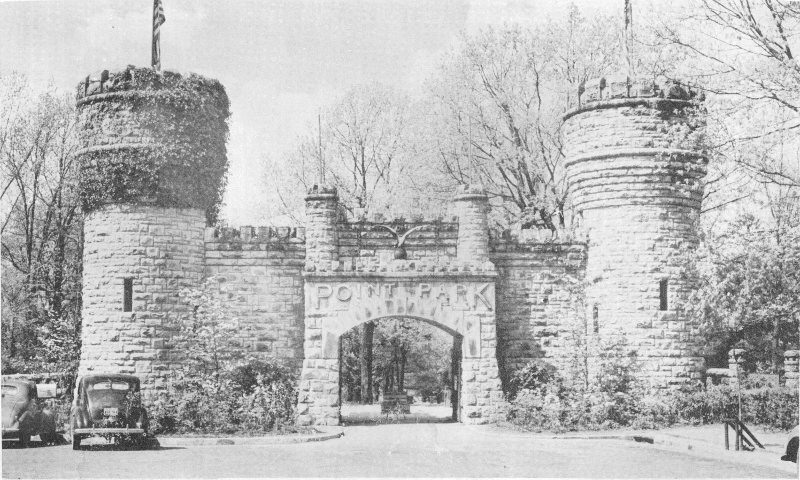
Entrance to Point Park. Lookout Mountain
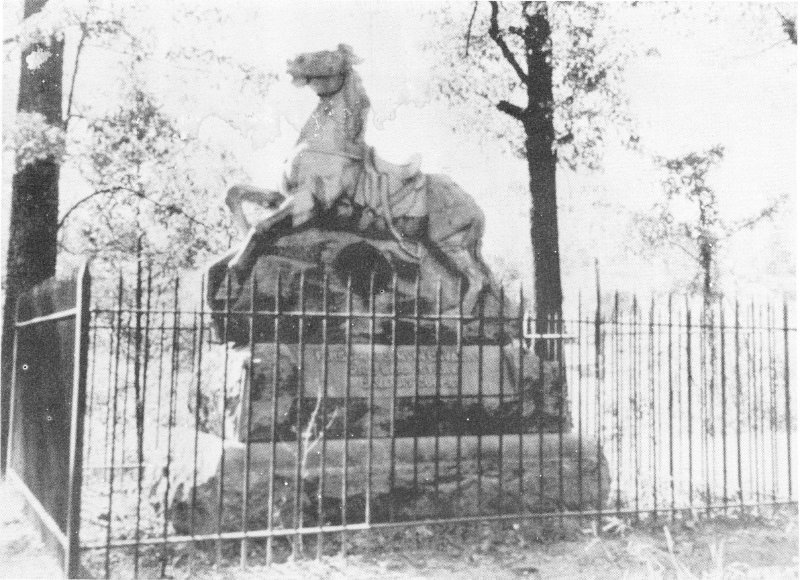
Riderless Horse—Chickamauga Battlefield
By an act of Congress, approved August 19, 1890, the Chickamauga and Chattanooga National Military Park was established, with a view to preserving and suitably marking those battlefields for historical and professional military study. The part undertaken by the Government in the establishment of this park embraced the purchase of lands, restoration of the fields, construction of roads and trails, building of observation towers, the erection of appropriate monuments to the regular troops engaged there, the preparation of hundreds of historical tablets for the various organizations of the contending armies, the mounting of original guns in their exact positions during the battles and the erection of shell pyramids, both of square-base and triangular-base type.
The park was created as a result of the reunion of the Army of the Cumberland which was held in Chattanooga, Tennessee, on September 19-20, 1889. At this reunion, the Chickamauga Memorial Association was formed. Gen. John T. Wilder was elected president and Gen. Joseph Wheeler vice-president. Then a Board of Directors, numbering 28, were elected. Of this number, an equal division was made of ex-Union and ex-Confederate officers.
Since that time the various states having troops in the battles have erected hundreds of beautiful, expensive monuments and markers which show the exact regimental positions of their troops. The tablets mark the brigade and division positions and give a brief history of their activities. The blue tablets mark the Union positions, while the red tablets mark Confederate positions. Another interesting thing to know is that all of these tablets have been placed in such a manner that when you are facing them, you are facing the same direction which the troops were facing at that time and place. Therefore, if anyone cares to follow up the movements of any particular organization, it can be done very easily.
Every effort has been made to restore the battlefields to their original condition. Speaking of the shell pyramids, there are 14 of the square-base type which mark the headquarters sites of either an army corps or the field headquarters of the commanding general. There are 8 of the triangular-base pyramids which mark the exact spot where each of the brigade commanders lost their lives. All of these are located on the Chickamauga battlefield. On Missionary Ridge, a bronze cannon-ball monument has been substituted for a pyramid. This also marks the site where a brigade commander lost his life. One original house stands on the Chickamauga battlefield; also three replicas of the original.
This is the largest and oldest of the National Military Parks. It is probably the first one on which the high-ranking officers of the contending armies ever met to determine their exact locations during the battles. The park consists of approximately 8,584 acres, and embraces the battlefields of Chickamauga, Orchard Knob, Lookout Mountain and Missionary Ridge, all of which were very important in military operations around Chattanooga, Tennessee, in the fall of 1863. The Chickamauga battlefield alone covers 5,562 acres.
In 1863 Chattanooga was a very small town with a population of only 4,000. Notwithstanding the small population, it was the objective of both the Union and Confederate armies. Its importance was chiefly due to the railroads that intersected here. There were rail connections to the Mississippi River at Memphis; to the Ohio River via Nashville and Louisville; to the Atlantic at Savannah and Charleston via Atlanta, and to Richmond via Knoxville and Lynchburg. In addition to this, Chattanooga was located on the Tennessee River. Therefore, with every transportation facility possible, its possession was of vital importance. Union troops in possession of Chattanooga, meant a wedge through the Confederacy, because Chattanooga was the “key” to east Tennessee and northwest Georgia. Furthermore, it would discourage the forwarding of supplies and the transportation of troops back and forth from Richmond to the areas in west Tennessee and Mississippi. The section of east Tennessee in which Chattanooga is located is one of the most fertile sections in the entire South for the production of grain. Not only wheat, corn and hay, but plenty of beef, bacon, horses and mules. All of these were of vital importance in the support of an army. In fact, both Governments profited from the resources of this area.
Another reason for Chattanooga’s importance was a political reason. All of the mountainous region of east Tennessee in which Chattanooga is located was exceptionally sympathetic with the Union. President Lincoln and his military advisers regarded the possession of Chattanooga by the Union army as second only in importance to the capture of Richmond—the Confederate capital. It was by far the most important city in Tennessee to place Union forces since it would encourage the Unionist sentiment and relieve the loyal citizens from Confederate control.
Eventually two major battles were fought for possession of Chattanooga. First, the battle of Chickamauga on September 19-20, which was a Confederate victory. Two months later the battle of Chattanooga was fought. This was a three-day battle. At Orchard Knob, Nov. 23rd; Lookout Mountain, Nov. 24th; Missionary Ridge, Nov. 25th. This was a very decisive victory for the Union army.
NOTE: In reading of the battles, please remember that any name used applies strictly to their commands unless otherwise explained.
At the outbreak of the Civil War, there were no Confederate soldiers in Chattanooga. They made their appearance in the spring of 1862—a year after the war started. These troops were commanded by Generals Floyd, Maxey and Leadbetter. It was only a short time until Union forces, commanded by General Mitchell, arrived. They shelled the city on June 7th and 8th, and the Confederates made a hasty exit. In August, General Braxton Bragg, commanding the Confederate army, invaded Chattanooga and started a campaign into Kentucky. After an unsuccessful campaign in Kentucky, Bragg was forced to fall back to Murfreesboro, Tennessee. At this time the Union army was at Nashville, Tennessee. On December 7 31, 1862, and January 1-2, 1863, the battle of Stones River, or Murfreesboro, was fought. This was a fierce battle which resulted in a Union victory. The victory enabled the Union army to spend the remainder of the winter in Murfreesboro, while the Confederates retreated southeastward to Tullahoma, Tennessee. At this time the Army of the Cumberland (Union) was commanded by Major-General William S. Rosecrans. The Army of Tennessee (Confederate) was commanded by General Braxton Bragg whom Fort Bragg, one of our most modern army posts, is named in honor of. Both armies were making preparations for future battles which they realized were forthcoming once winter was over. The Confederates posted a strong line of cavalry on the north side of the Duck river. Their infantry positions were strongly fortified. The winter months were long and severe, and you may be sure that both armies endured many hardships. The Union plans called for Rosecrans to take Chattanooga and Atlanta, both important railroad centers, during 1863. In fact, Chattanooga was an important railroad center as early as 1850. Both armies were rather idle for several months although Rosecrans was being urged to renew hostilities against Bragg.
Finally, on June 23, 1863, Rosecrans left Murfreesboro, moving against Bragg at Tullahoma. By exercising very clever strategy in the form of a series of flanking movements, the Confederates were forced to give up one stronghold after another. The Confederates finally crossed the Tennessee River at Bridgeport and Caperton’s Ferry, Alabama, and moved directly into Chattanooga. The first arrival at Chattanooga was at the same hour that General Pickett made his famous charge at Gettysburg, namely near high noon on July 3rd. By this time the Union army had advanced to the western base of the Cumberland Mountain. The right of their line was at Winchester; the left at McMinnville. Rosecrans, with his headquarters at Winchester, was making preparations for another campaign for occupying Chattanooga. At this time Chattanooga was of utmost importance to both armies, and no doubt the largest prize from a military standpoint which the Army of the Cumberland ever contended for. The Confederates had destroyed the bridge across the Tennessee River at Bridgeport to delay the pursuit of the Union Army. The Union army consisted of three regular Army Corps; the 14th, commanded by Maj.-Gen. George H. Thomas; the 20th, commanded by Maj.-Gen. Alexander McCook, and the 21st, commanded by Maj.-Gen. Thomas L. Crittenden. The Cavalry Corps was commanded by Brig.-Gen. Robert Mitchell; the Reserve Corps was commanded by Maj.-Gen. Gordon Granger. The disposition of the Union forces was as follows:
Thomas was posted at Decherd; McCook at McMinnville, and Crittenden at Winchester. Again Rosecrans was urged to renew hostilities against Bragg. The Cumberland, Raccoon and Lookout Mountain ranges and the Tennessee River were some of the giant obstacles between Rosecrans and Chattanooga. To cross these required a maximum of time and supplies as it was quite a task. There were railroads to repair; the river bridge to be rebuilt. All of this required time and labor. It was humanly impossible for Rosecrans 8 to begin a forward movement at this time. By extending every effort possible, it was July 25th before the railroads were repaired. Another weighty consideration of Rosecrans was the necessary forage for the animals. Having knowledge that corn would not be ripe in east Tennessee and northern Alabama before the middle of August, Rosecrans insisted on waiting until that time before he launched another campaign. Officials of the War Department were eager for action on the part of Rosecrans.
On August 4th, Gen. Halleck sent a message to Rosecrans which said: “Your forces must move forward without delay. You will daily report the movement of each corps till you cross the Tennessee River.” Since Rosecrans was not ready for the movement, he replied: “Your dispatch ordering me to move forward without delay, reporting the movements of each corps till I cross the Tennessee River received. As I have determined to cross the river as soon as practicable, and have been making all preparations and getting such information as may enable me to do so without being driven back, like Hooker, I wish to know if your order is intended to take away my discretion as to the time and manner of moving my troops.” To this message Gen. Halleck replied: “The orders for the advance of your army, and that it be reported daily are peremptory.” This latter message did not set well with Rosecrans. He prepared his reply and after conferring with his corps commanders and receiving their assurance that they would support him, he sent the following message: Gen. Halleck: “My arrangements for beginning a continuous movement will be completed and the execution begun Monday next. We have information to show that crossing the Tennessee River between Bridgeport and Chattanooga is impracticable, but not enough to show whether we had better cross above Chattanooga and strike Cleveland, or below Bridgeport and strike in their rear. The preliminary movement of troops for the two cases are quite different. It is necessary to have our means of crossing the river completed and our supplies provided to cross 60 miles of mountains and sustain ourselves during the operations of crossing and fighting, before we move. To obey your order literally would be to push our troops into the mountains on narrow and difficult roads, destitute of pasture and forage; and short of water where they would not be able to maneuver as exigencies demand, and would certainly cause ultimate delay and probable disaster. If, therefore, the movement which I propose can not be regarded as obedience to your order, I respectfully request a modification of it or to be relieved from the command.”
Gen. Halleck wired him as follows: “I have communicated to you the wishes of the Government in plain and unequivocal terms. The objective has been stated, and you have been directed to lose no time in reaching it. The means you are to employ and the roads you are to follow are left to your own discretion. If you wish to promptly carry out the wishes of the Government you will not stop to discuss mere details. In such matters I do not interfere.”
Rosecrans replied the same day. His message read: “Your dispatch received. I can only repeat the assurance given before the issuance of the order. This army shall move with all dispatch compatible with the successful execution of our work. We are pressing everything to bring up forage for our animals. The present rolling stock of the road will barely suffice to keep us day by day here, but I have bought 50 more freight cars, which are arriving. Will advise you daily.” There was no further interference from Washington.
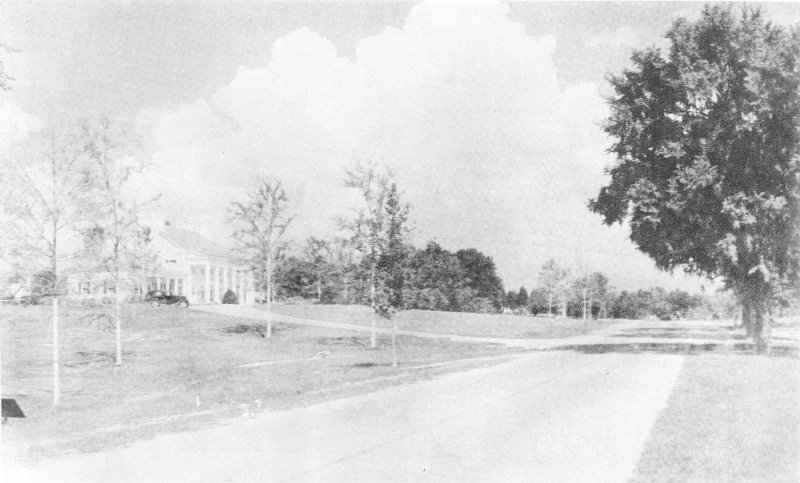
Park Headquarters, Chickamauga Battlefield
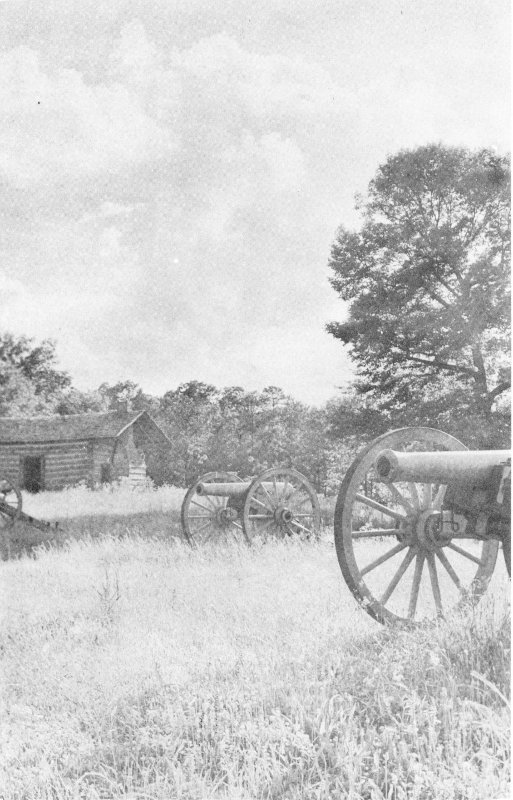
Snodgrass House, Chickamauga Battlefield
On August 16th, the Union army started their forward movement. Thomas and McCook moved their corps down to the Tennessee River at Bridgeport. Crittenden moved down the Sequatchie Valley, having troops from just north of Jasper to a point above Pikeville. A part of the latter’s corps, (Wilder’s and Wagner’s Mounted Infantry) took positions along Walden’s Ridge and Signal Mountain where they were in plain view of the Confederates in Chattanooga. Numerous demonstrations were made at these points to attract the attention of the Confederates and to make them believe they were attempting to cross the river at some point above the city. They would beat on empty barrels to imitate the rolling of supply wagons. They also built huge bon-fires and would march back and forth in the flare of them. Buglers were placed at distant points where they would strike a few notes at regular intervals. They even sawed planks, boards and pieces of logs to float down the river to give the Confederates the impression they were building a pontoon bridge at some point above the city. On August 21st, a part of Wilder’s brigade advanced to Stringer’s Ridge where they shelled Chattanooga with artillery. One shell landed in front of the First Presbyterian Church at Seventh and Market streets, while services were being conducted. Some reports claim that a little girl had her leg broken by a piece of shell. However, according to the report of Confederate Gen. D. H. Hill, several women and children were killed. Today, Chattanooga’s tallest building, the Hamilton National Bank, stands on this site. The shelling of the city showed that the Union troops were on the immediate front of the Confederates. As a result, Cleburne’s division was sent to Harrison, and then distributed at every ford and ferry between the mouths of the Chickamauga Creek and the Hiwasee River—a distance of at least 50 miles. These troops were so placed in order to guard against any possible crossing by the Union troops. All of these positions were covered by rifle-pits and batteries. With the Confederates’ attention drawn in this direction, the main body of the Union army effected a crossing of the river at Bridgeport, 30 miles below Chattanooga, between August 29th and September 4th, unmolested. Thomas crossed over the Sand Mountain to Trenton, Georgia, after much difficulty.
When Bragg learned that the Union army had crossed the river below him he evacuated Chattanooga during the 8th and 9th of September, moving 26 miles southward to LaFayette, Georgia, behind the Pigeon Mountains. This movement was made in order that he could protect his line of communications and his base of supplies, his base being Atlanta. As the last of Bragg’s army was leaving the city on the morning of September 9th, the 92nd Illinois Mounted Infantry made a reconnaissance on Lookout Mountain. They then entered the city. Crittenden’s corps followed the railroad to Ringgold, 12 then westward to Rock Springs in pursuit of the Confederates. At this latter point, Crittenden was directly between Bragg and Chattanooga.
Rosecrans was led to believe that Bragg was in full retreat to Rome and Atlanta. He had gathered this information from pretended deserters from the Confederate army. However, he was determined to head the Confederates off. He immediately dispatched Thomas and McCook down Lookout Valley to point 26 and 42 miles below Chattanooga where they crossed Lookout Mountain. Thomas moved into McLemore’s Cove; McCook to Alpine and Summerville, Georgia. In planning these movements and making such disposition of his troops, Rosecrans was falling into a trap which had been set for him. Bragg’s army was not in retreat. They had no intentions of retreating. Rosecrans was not aware of the fact that Bragg was not in retreat until about September 12th. His army was divided into three sections. It was at least 60 miles from the left to right of his troops. Meanwhile, Bragg at LaFayette, was opposite the Union center and in position to attack and crush the Union army in detail as they emerged from the mountains. He had already been re-enforced by Buckner from east Tennessee and Walker from Mississippi. He was only awaiting Longstreet’s arrival from Virginia before turning back in an effort to retake Chattanooga. The latter named troops were seasoned veterans who were sent down by Gen. Lee. A great many of them had fought in the battle of Gettysburg. Upon their arrival Bragg ordered the Confederates to turn back toward Chattanooga. His plan was to attack Crittenden and in case Thomas and McCook should arrive they could be taken care of, likewise, in order. Failure of his subordinate officers to comply promptly with these orders caused this opportunity to be lost. Rosecrans, upon learning that Bragg had received heavy re-enforcements and was turning back in an effort to retake Chattanooga, hurriedly ordered the concentration of his forces. McCook, contrary to orders, took a roundabout route from Summerville, causing some delay. However, on September 17th, he joined Thomas and they in turn started their movement to join Crittenden. At this time Crittenden was on the west side of Chickamauga Creek at Lee and Gordon’s Mill. It was necessary for Thomas and McCook to make a forced march day and night in order to reach Crittenden. They were practically exhausted when they reached him.
On September 17th, Bragg had ordered his troops to cross the Chickamauga Creek at Reed’s and Alexander’s bridges. They were to sweep up the creek toward Crittenden’s position. His objective was to gain possession of the main road between Rosecrans and Chattanooga. Incidentally, this main road is known today as Highway U. S. No. 27. The Confederates reached Chickamauga Creek on Friday afternoon, September 18th. Here they met with some opposition from the Union troops. After a great deal of skirmishing, of which some was rather severe, the Confederates effected a crossing.
On Saturday morning the right of the Confederate line extended to the Reed’s Bridge road. Forrest’s Cavalry Corps was posted on 13 the right of this line. Thomas’ troops arrived on the LaFayette road at the Kelley field near daylight on Saturday morning, the 19th. Brannan’s division moved up the main road to the McDonald field, thence east toward Reed’s bridge. When in the vicinity of Jay’s Mill they encountered Forrest’s cavalry. Croxton’s brigade fired into them and thus opened the battle of Chickamauga. Forrest’s men dismounted and returned the fire, fighting as infantry. It was now 7:30 A. M. The battle was slow to start. Then it became severe. Both sides sent for re-enforcements which were sent at once. Connell’s and VanDerveer’s brigades came to Croxton’s support while Walker and Liddell brought their divisions to Forrest’s assistance. Due to the Confederates not being in the positions which Bragg had ordered them, a great deal of confusion resulted. However, troops kept filling in on both sides until the lines were about three miles in length. Each side gained and lost ground many times by severe charging and counter-charging. Baird made an effort to reform his lines but while doing so, was attacked by Walker in greater numbers. King and Scribner were driven back some distance at the same time. The Union forces then drove Walker to his former position. At this time Cheatham came to Walker’s rescue and they drove Johnson, Palmer and VanCleve back in order. Reynolds was then overpowered by the Confederates, the rebels yelling wildly all the while. Davis and Wood then checked the advance of the Confederates. After adjusting their lines, they drove Cheatham, Walker and Stewart back to their former positions. Most of the fighting was in the woods at this time although some was in open fields. Much of it was at very close range. In just such manner the fighting lasted all the forenoon, neither side gaining very much. Casualties were high on both sides. It is believed that the 10th and 74th Indiana Infantry were the most severely engaged at this time. It may be interesting to learn that Col. William B. Carroll, commanding the 10th Indiana Infantry, was the first field officer to be killed at Chickamauga. By noon the fighting was general throughout the lines.
During the afternoon the most severe fighting took place near the opposite ends of the lines in the Vineyard field. Fighting at this point was all at close range and some was hand-to-hand. About 4:00 P. M., Col. Hans C. Heg, 15th Wisconsin Infantry, was mortally wounded. Col. Heg commanded the 3rd brigade of Davis’ division. With death staring him in the face, he again rallied his men and rode nearly one-quarter of a mile before the loss of blood weakened him to such an extent that he was forced to give up his command. His brigade was taken over by Col. John A. Martin of the 8th Kansas Infantry. Col. Heg was the first brigade commander to fall on the Chickamauga battlefield. After a restless night in a hospital, he passed away near noon of the 20th. After sundown the fighting ceased at all portions of the field. Neither side had gained any worthwhile advantage during this first day of battle, although the Union forces had been driven much closer to the main road. The left of the Union line under Thomas was well anchored across the main highway; the center under McCook was just west of the highway, and the right end of the line under Crittenden was still east of the highway. The Confederate line was very close to the Union line at all points. Shortly after dark the battle was renewed near the north 14 end of the lines. Cleburne and Cheatham encountered Johnson and Baird. The fighting lasted only about an hour but the losses were heavy. Two brigade commanders lost their lives about 7:00 P. M. On the Union side, Col. Philemon P. Baldwin of Indiana, was killed. Col. Baldwin commanded the 3rd brigade of Johnson’s division. Col. William W. Berry of the 5th Kentucky Infantry, assumed command of Baldwin’s brigade. On the Confederate side, Brig.-Gen. Preston Smith of Tennessee was killed. Gen. Smith commanded a brigade of Cheatham’s division. Col. Alfred J. Vaughn, Jr., 13th Tennessee Infantry, assumed command of Smith’s brigade. During the night both armies rearranged their lines in preparation for the next day’s battle. The right end of the Union line was shifted from the vicinity of the Vineyard field westward to the Crawfish Springs road near Widow Glenn’s. The Confederate line remained east of the highway at all points, slightly over-lapping the Union line on either end. The troops on the left of the Union line fortified their positions during the night by falling trees, stacking rails, stumps, etc., in preparation for Sunday’s battle. On the Confederate side Longstreet, the South Carolinian, arrived with his corps about 11:00 P. M. At this time Bragg divided his army into two wings, the left and right. Longstreet was given command of the left wing; Gen. Leonidas Polk, the North Carolinian, who was the first Protestant Episcopal Bishop of Louisiana, was placed in command of the right wing. Bragg gave order for the battle to be resumed at daylight on Sunday morning. His plan was to launch the Confederate right against the Union left, with each division and brigade to their left to take up the firing in order until the battle became general throughout the field. Hill’s corps was on the right of the Confederate line. Breckinridge commanded the extreme right division. The latter had three brigades, commanded by Helm, Adams and Stovall.
Sunday morning came. The battle was not resumed at daylight. Sunrise came, but still no battle. Bragg was waiting impatiently, listening and wondering. His orders were not being carried out, even in part. Finally, becoming nervous, he went in search of Polk, Hill and Breckinridge. He was determined to find the cause for delay. It seems that everyone but the right one had received their orders. Hill claimed he had no knowledge of Bragg’s plan, although his division commanders had received their orders. Some of the Confederates had not had their breakfast, although it was considerably past the breakfast hour. None of the troops were in position for battle as had been ordered. This necessitated a great deal of rearrangement in the lines. It is a known fact that Hill did not approve of Polk being in a higher command than himself. Hill insisted that he was senior to Polk in his rank. Possibly this caused the delay in resuming the battle. About 9:00 o’clock, the Confederate right was thrown forward against the Union left. The logworks were too strong for the Confederates. Time and again they charged, to be driven back with severe losses. This fighting was at very close range. Helm’s brigade was almost shattered, and while engaged in this desperate struggle, the commander, Brig.-Gen. Ben Hardin Helm of Kentucky was mortally wounded. Helm was a brother-in-law of President Lincoln’s wife. However, fragments of his brigade, in addition to Adams and Stovall, gained the left and rear of the Union left and entered the Kelley field. Later they were repulsed. Gradually the battle rolled from right to left along the Confederate line. Longstreet, near the Confederate center, was opposite the Brotherton house. About 11:15 A. M., a gap was created in the Union center when Wood’s division, through the misunderstanding of an order issued by Rosecrans, withdrew from the line and marched to the left and rear of Brannan.
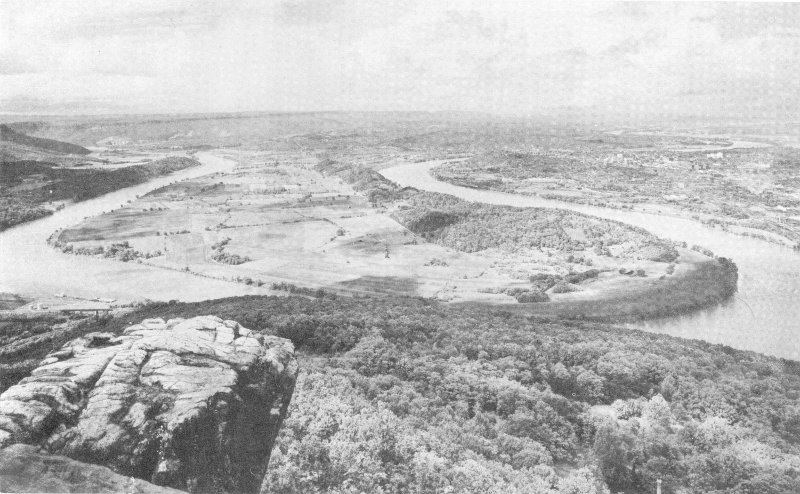
View from Point Lookout overlooking Moccasin Bend with Chattanooga in background.

The famous Umbrella Rock, Lookout Mountain
Longstreet, with eight brigades, forced their way through, throwing the right and right center of the Union line back in confusion. Rosecrans, McCook and Crittenden left the field. A great many of the troops under the latter named two left the field. Some few of them later rallied and remained on the field during the afternoon. Gen. Thomas, then being the senior officer on the field, immediately assumed command. Holding a pivot with the extreme left of his line, the right end moved back until it reached Snodgrass hill. This gave him an almost impregnable position. With this newly formed east-west line he could check the advance of the Confederates and also cover Rosecrans’ retreat. The Confederates, upon crossing the road, changed front with their artillery. Their infantry swept around like a large gate on hinges. By almost continuous advancing, the Confederates reached the south side of Snodgrass hill where they established their line. Within less than an hour from the time of the break in the Union line, three other brigade commanders lost their lives. Near the Confederate right, Col. Peyton H. Colquitt, 46th Georgia Infantry, was mortally wounded about noon. Colquitt commanded Gist’s brigade of Walker’s division. Lt.-Col. Leroy Napier assumed command of Colquitt’s brigade. A short distance to the south, Brig.-Gen. James Deshler of Texas was killed about the same time. Deshler commanded a brigade in Cleburne’s division. His command was taken over by Col. Roger Q. Mills. Farther to the southwest in the Union line, Brig.-Gen. William H. Lytle, the Cincinnati soldier-poet, was killed while trying to rally his brigade against the Confederate sweep to the north. Lytle commanded the 1st brigade of Sheridan’s division. His command was taken over by Col. Silas Miller of the 36th Illinois Infantry.
By 2:00 P. M. the battle was raging on Snodgrass hill. This fighting was at very close range and a great deal was hand-to-hand struggling. The Confederates kept charging up the slopes, making every effort to drive the Union troops from their position. They were never able to carry the hill. A few of the Confederates passed over the hill to the right of the Union line. They moved to the rear of Brannan and entered the valley beyond his position. About 3.00 P. M., when the fighting reached its peak, Longstreet sent to Bragg for re-enforcements from the right wing. However, he never received them. On the contrary, he was told by Bragg that the troops of the right wing had been beaten back so badly that they would be of no service to him. There were Confederates in reserve which had scarcely been engaged, if Longstreet could only have gotten them. Along the Union line, it was quite different. At 3:30 P. M., Steedman’s division of Granger’s reserve corps came to Thomas’s assistance. These re-enforcements consisted of Mitchell’s and Whitaker’s 18 brigades. They drove the Confederates from the rear of Brannan, strengthened and prolonged the Union line westward. They also passed out ammunition along the line. While the fighting was so severe the woods caught on fire. This was caused by the artillery firing so low. Hundreds of the soldiers, both Union and Confederate, were burned and scorched beyond recognition. Steedman no doubt saved Thomas from having to retreat from the hill since the latter’s ammunition supply was completely exhausted. It was at this point that Thomas gained the name of “The Rock of Chickamauga.”
At 4:45 P. M., Thomas received orders from Rosecrans directing him to withdraw. The withdrawal was not started at this time. There had been severe fighting in the Kelley field during the afternoon. At 5:00 P. M. Col. Edward A. King, 68th Indiana Infantry, was killed in the southeast corner of this field. King commanded the 2nd brigade of Reynolds division. He was the last of the eight brigade commanders who lost their lives on the Chickamauga battlefield. Col. Milton S. Robinson assumed command of his brigade. About 7:00 P. M., Thomas began to withdraw. The Confederates had gained possession of the LaFayette road to the left and rear of the Union line. Since Thomas wanted to re-establish his lines between Bragg and Chattanooga, the withdrawal was made via McFarland Gap to Rossville; then south on the Chattanooga-LaFayette highway to Rossville Gap and Missionary Ridge. Fortifications were thrown up along this portion of the ridge to keep the Confederates in check. The Union line also extended across Chattanooga Valley and up the slopes of Lookout Mountain. Thomas held this line along Missionary Ridge throughout Monday, the 21st. During the night they abandoned this position and moved into Chattanooga. Thus ended the battle of Chickamauga.
There were approximately 124,000 troops engaged at Chickamauga. Of this number, there were 58,000 Union soldiers and 66,000 Confederates. During the two-day battle, there were 34,000 casualties. Of these casualties, there were 16,000 Union; 18,000 Confederates.
The Union army had lost the battle of Chickamauga. Still they had reached their objective—Chattanooga. Bragg’s plan was to attack the Union troops in Chattanooga on the morning of the 22nd. However, this failed to materialize. After some light skirmishing it was decided to call off this attack due to the Union troops being too strongly entrenched. The Union army was still holding their line up Lookout Mountain. Soon this line was abandoned since they realized that Bragg would only have to place forces at any point below in order to have control of the river line of supplies.
Both Rosecrans and Bragg immediately started a reorganization of their armies. The Confederate army was divided into three corps, the commands being given to Longstreet, Hardee and Breckinridge. These three corps had a total of 10 divisions. Wheeler was in command of the cavalry. On the Union side, McCook and Crittenden were removed from their commands of the 20th and 21st Army Corps. These two corps were consolidated into the 4th and Granger was given the command. The Reserve Corps which was formerly commanded by Granger was consolidated into the 14th Army Corps, Maj.-Gen. John M. Palmer, commanding. The Union army at this time had six divisions, commanded by Baird, Cruft, Davis, Johnson, Sheridan and Wood. The Artillery Reserve was commanded by Brannan. This latter force consisted of two divisions, each with two brigades. Col. Parkhurst commanded the Post of Chattanooga.
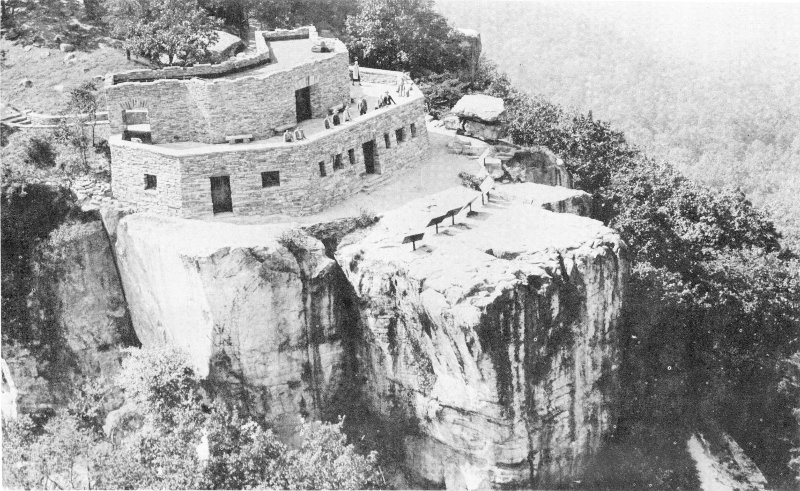
Ochs Memorial Observatory, Lookout Mountain
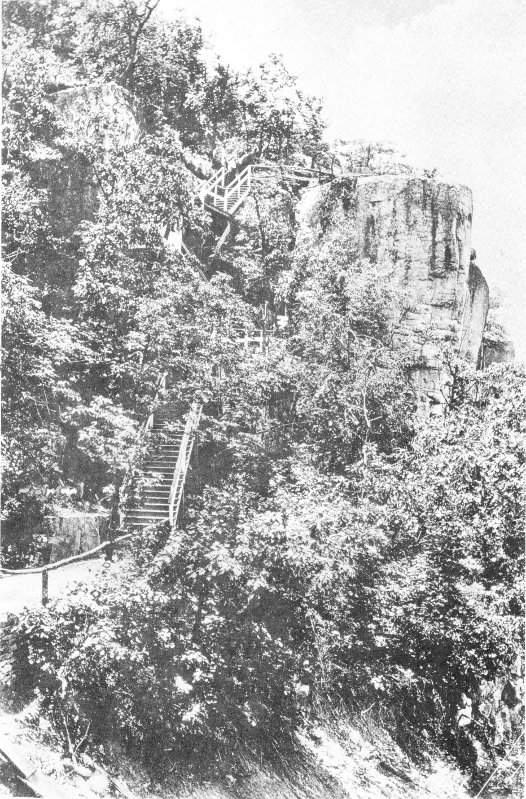
Roper’s Rock. Lookout Mountain
Ladder represents where the Union troops reached the top.
Bragg was determined to lay siege to the city and force the Union army into surrendering by starvation. While the Union army was strongly entrenching their positions in Chattanooga, the Confederates were establishing their lines on Missionary Ridge, east of the city, and Lookout Mountain, southwest of the city. A strong picket line was placed along the river from Chattanooga Creek to a point below Williams Island, including Brown’s Ferry. Another similar line was placed from just below the city to a point near the mouth of the Chickamauga Creek. A skirmish line was thrown out about one mile in front of Missionary Ridge. A short range of hills, of which Orchard Knob was the highest, was covered by this skirmish line. These Confederate positions controlled all supply lines south of the river, which meant railroads, highway and the river itself. The Union army was soon in dire straits. The only route which was left open was to cross the river north of the city, then cross Walden’s Ridge or Signal Mountain; thence down the Sequatchie Valley to Bridgeport and Stevenson. This route was about 65 miles long and most of it was mountainous roads. The fall rains had set in and this route was almost impassable. The Union supply wagons were easy prey for the Confederate cavalry which had been dispatched north of the river to conduct raids. Wheeler captured dozens of the supply wagons, killing the horses and burning the wagons. The Union base of supplies was Nashville—160 miles distant by very rough roads. Cattle were driven all this distance in many instances to feed the hungry soldiers. By the time the cattle reached Chattanooga (if they did not die enroute), they were so poor that the Union troops often remarked that they had nothing to eat but “hard tack” and “dried beef on the hoof.” To say the Union soldiers were in destitute circumstances would be a mild way of expressing their actual condition. Half rations, then quarter rations and less. At times the soldiers only had a little raw corn to eat. Finally it was necessary to place a sentry at the horse troughs in order to keep the soldiers from taking the grain which was fed to a few choice mounts. Even then, the Union army lost between 12,000 and 15,000 of their finest horses and mules from starvation. The troops were in a starved, sickened condition, and very low in spirits. No doubt they thought they were doomed, and that no one would come to their rescue before they starved. However, in this surmise, to their great joy, they were mistaken. It had been practically a month since their defeat at Chickamauga, but let us review a little to see what was being done to relieve this besieged army. Almost immediately after the battle of Chickamauga, Gen. Grant started Gen. Sherman from Vicksburg with four divisions (Army of the 22 Tennessee) to the assistance of Rosecrans. These re-enforcements consisted of the 1st, 2nd and 4th divisions of the 15th Army Corps, commanded by Brig.-Generals Peter J. Osterhaus, Morgan L. Smith and Hugh Ewing, respectively. Also the 2nd division of the 17th Army Corps, commanded by Brig.-Gen. John E. Smith. Thirteen brigades were represented by Sherman’s re-enforcements.

Steamboat Being Warped Through “The Suck” Before the Dam at Hale’s Bar was built in the Tennessee
A detachment from the Army of the Potomac consisting of the 11th and 12th Army Corps, commanded by Maj.-Gen. Joseph Hooker, were sent from Virginia to help lift the siege. The 11th corps was commanded by Maj.-Gen. O. W. Howard. Howard had the 2nd and 3rd divisions, commanded by Brig.-Gen. Adolph von Steinwehr and Maj.-Gen. Carl Schurz, respectively. The 12th corps, commanded by Maj.-Gen. Henry W. Slocum, had the 1st and 2nd divisions, commanded by Brig.-Generals Alpheus S. Williams and John W. Geary, respectively. Twelve brigades were represented by Hooker’s re-enforcements. Hooker’s troops left Virginia on September 25th. These troops came by the B. and O. Railroad via Indianapolis, Louisville, Nashville and Bridgeport. The advance of this column reached Bridgeport September 30th. They were supposed to have helped to reopen the Tennessee River the next day. This was impossible due to his supply trains not being here at that time. Rosecrans had devised a plan whereby the river supply line could be opened up. His plan was to seize Brown’s Ferry from Chattanooga, and bring Hooker forward into Lookout Valley at the same time. The execution of this plan only awaited completion of pontoon-boats for the necessary bridge. When they were ready, Wheeler made another raid north of the river, delaying the Union troops again. The date for the execution of this movement was then set for October 19th. On this 23 date Rosecrans personally selected the site for throwing the bridge. It has been reported that Rosecrans rowed a boat himself. When he returned to his headquarters he found orders relieving him, and placing Thomas in command. On October 23rd, Gen. Grant arrived in Chattanooga. He approved of Rosecrans’ plan and ordered it executed at once. Thomas at once repeated Rosecrans’ order to Hooker, ordering him forward into Lookout Valley. Hooker’s supply trains reached him October 26th. He left Bridgeport on the 27th, reaching Brown’s Ferry the next day. In the meantime, during the night of the 26th, a part of two Union brigades marched across Moccasin Point, concealing themselves near Brown’s Ferry. About 3:00 A. M. of the 27th, there were 50 pontoon-boats placed in the Tennessee River, each carrying 30 men. These boats floated down the river under cover of darkness, rounding Moccasin Point unobserved by the Confederate pickets. By a quick crossing from the north bank to the south bank, they took the Confederates by surprise and soon captured this position. The pontoon-boats were then leashed together, forming a bridge across the river. At this time the troops which had marched to this point crossed and joined the others on the south bank.
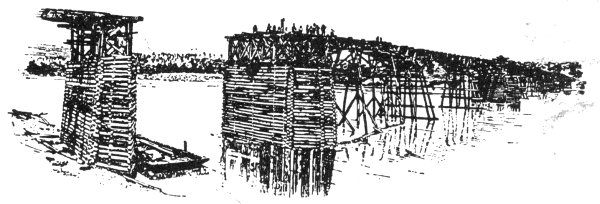
Military Bridge, Tennessee River, 1863
After Hooker’s arrival in Lookout Valley during the afternoon of the 28th, Geary’s division stopped at Wauhatchie, four miles below the northern point of Lookout Mountain. This was at a junction of the Nashville and Trenton railroads. Generals Bragg and Longstreet stood on Lookout and witnessed their arrival. About midnight Geary was attacked by Jenkins’ division of Longstreet’s corps. The battle lasted until about 3:30 A. M. Geary was reinforced by two brigades commanded by Tyndale and Orland Smith. Then the Confederates withdrew across Lookout Creek and onto the northern slopes of Lookout Mountain. This battle gave the Union army complete control of all short supply lines. The Confederates never made any further effort to regain control of this short route. The starving troops in Chattanooga were hurriedly refitted and Grant was only awaiting the arrival of Sherman before attacking the Confederates in their strong positions. Meanwhile, the Confederates were still clinging to their positions with the utmost confidence in holding them. On November 4th, Longstreet was sent to Knoxville to oppose Gen. Burnside. His command constituted about one-third of the Confederates. Naturally his departure shattered the Confederate hope.
On November 18th, Sherman arrived at Trenton. He moved to Brown’s Ferry at once, crossing three of his divisions commanded by M. L. Smith, Ewing and J. E. Smith.
Osterhaus was unable to cross his division due to the breaking of the bridge. He was then ordered to report to Hooker, which he did at once. From November 21st to the 23rd, Sherman was in a concealed camp behind Stringer’s Ridge, and near north Chickamauga Creek. His troops floated pontoon boats down this stream into the Tennessee River. From the north side of the river Sherman selected a high hill on the south bank which he thought was the north end of Missionary Ridge.
Grant had ordered an attack against the Confederates on the 21st. Due to bad roads, Sherman was unable to reach here by that time. When the battle did open on the 23rd, it was not according to plan. Under Grant’s original plan, Hooker was to hold Lookout Valley with Geary’s and Cruft’s divisions. The 11th corps was to be brought into Chattanooga to assist either Sherman or Thomas. Sherman was to cross the river at the mouth of the Chickamauga Creek during the night of the 23rd, and carry Missionary Ridge as far south as the tunnel, which at this time was not occupied by the Confederates. When Sherman reached this position, Thomas was to move to the left, connect with Sherman’s right, sweep up the valley and crowd the Confederates from their depot at Chickamauga Station, Tennessee, their communications and positions on the ridge. The battle did not progress as planned.
On November 23rd, reports reached Grant’s headquarters to the effect that Confederates had been seen retreating from Missionary Ridge. This was Buckner’s Corps leaving for Knoxville to assist Longstreet. Grant at once ordered an attack against Orchard Knob, the outpost of the Confederates in front of Missionary Ridge. Thomas, with five divisions, charged out against this position, soon capturing it. The Confederate pickets moved back to the base of the ridge. Grant then established his field headquarters at this newly acquired point immediately, where the entire Confederate line could be seen.
Hooker’s command had been assigned to Thomas who had obtained permission for Hooker to make a demonstration against the left of the Confederate line on Lookout Mountain. During the night of the 23rd, Sherman crossed the Tennessee River near the present site of the Chickamauga Dam. He reached the hill he had selected before crossing. He made no effort to dislodge the Confederates during the 24th. His position was not on the north end of the ridge as he thought it to be. A deep ravine separated him from the main north end of the ridge. From this position, the Confederates could be seen to the south. Early on the morning of the 24th, Hooker left Wauhatchie, moving northward to within two miles of the point of the mountain. His troops climbed the slopes to the foot of the palisades, made a march northward until they were near the point. 25 They were then joined by Osterhaus’ division which came directly up the northern slopes of the mountain. They were met with a sharp volley of fire from the Confederates as they emerged from the woods. The Confederates had two entrenched lines running from the foot of the cliffs to the river. They were driven out of the first line into an open field—the Craven’s farm. Here the fighting was desperate and the casualties were very heavy. The Craven’s house was used as the Confederate headquarters. The Confederates withdrew to their second line of entrenchments. While in this latter position the battle ended. The sharp-shooters and the two Confederate batteries on top were of little value during the battle. The Union soldiers never reached the top of the mountain during the battle, nor did they make any effort to. Therefore, there was no fighting on top of the mountain. It was so foggy during the day that the artillerymen or sharpshooters on the top were unable to see the troops on the slopes. The artillery could not have been depressed sufficiently to reach the Union troops at the foot of the cliffs—almost directly under them. It was the troops on top that nicknamed this battle the “Battle Above the Clouds.” The Confederates were outnumbered at least four to one during this battle. They were in danger of being surrounded, so during the night Bragg ordered the withdrawal of all troops from the top, the slopes and Chattanooga Valley. By daylight of the 25th, all of the Confederates were on Missionary Ridge to strengthen and prolong their lines at that point.
The withdrawal of the Confederates from Lookout Mountain left the Union forces in complete control of this point. At sunrise on the morning of the 25th, there were volunteers from the 96th Illinois and 8th Kentucky Infantry who scaled the rock palisades and reached the top of the mountain. They moved to the extreme northern point where they planted their flag of victory. A series of stairways has been erected to mark the exact route by which these Union troops climbed out on top of the mountain.
At this time Sherman was in position to attack the right end of the Confederate line. Thomas was in front of the center and Hooker was opposite the left end. About 7:30 A. M., Sherman opened the battle against the right end with heavy artillery fire. The Confederates of Cleburne’s, Stevenson’s and Cheatham’s divisions were so strongly entrenched that he was unable to drive them from their positions. About 10:30, Hooker was ordered forward across the Chattanooga Valley to attack the left end. The Confederates had destroyed the bridge across Chattanooga Creek and Hooker was delayed at least three hours in reaching Rossville. He then moved via Rossville Gap against the Confederate left. While these movements were being carried out by Sherman and Hooker, Thomas was to charge out against the Confederate rifle pits at the base of the ridge. With this latter movement it was thought the Confederates would be drawn toward the center from both ends, thereby giving Sherman and Hooker more chance of success toward turning the ends. Some of Hooker’s troops crossed to the east side of the ridge; some moved along the crest, and others remained on the west side of the ridge. At 3:30 P. M., Thomas, with the troops which had carried Orchard 26 Knob on the 23rd, charged out against the Confederate rifle pits. After a short battle, the Confederates started their retreat up the ridge. Thomas’ men pursued without orders, both the Union and Confederate troops reaching the crest of the ridge about the same time. The Confederate artillery on top of the ridge was forced to fire high since their own troops were between their artillery and the Union forces which were following them. For at least two miles along the central portion of the ridge, a severe hand-to-hand battle took place. Never in the entire Civil War did troops fight any harder than they did at this point. The casualties were heavy on both sides. Finally, the Confederate center was broken in several places and the center and left end started to retreat southward. At nightfall, Bragg ordered the right of the Confederate line to withdraw and cover the general retreat. As the Confederates were retreating, it is reported that their own artillery was turned upon them. The Confederates moved south via Chickamauga Station, Tennessee, thence to Ringgold, Georgia, where they stopped to offer battle again on November 27th. They retreated to Dalton, Georgia, where they went into winter quarters on December 1st. Gen. Bragg was removed from his command the next day. Gen. Hardee was offered the command but declined, although he accepted temporary charge until December 16th. At that time Gen. Joseph E. Johnston assumed command—a position he held until July 17, 1864, when he was replaced by Gen. John B. Hood. The Union troops moved back to Chattanooga where they entrenched their position and went into winter quarters, thus successfully ending the Chattanooga campaign. The city remained in possession of the Union army until the close of the war.
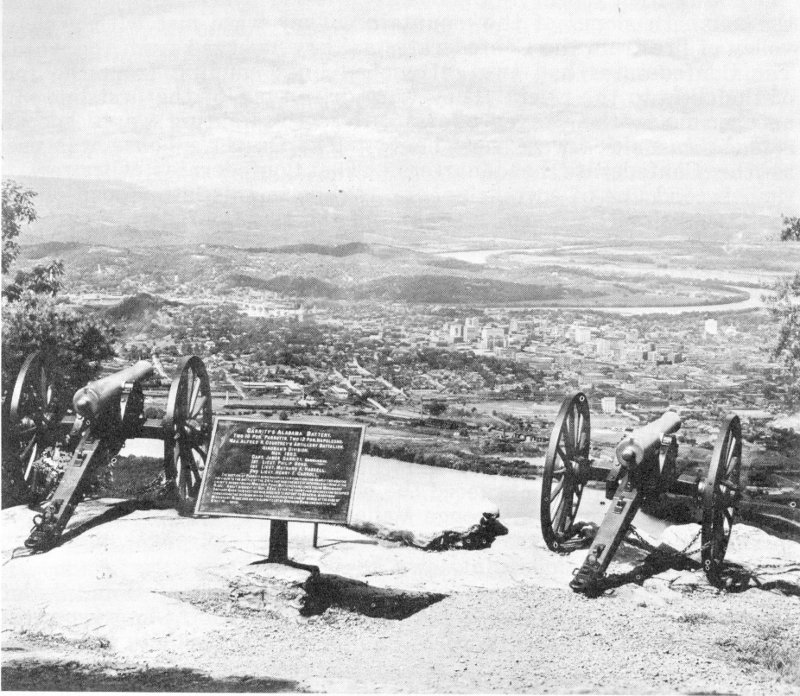
Confederate Battery atop Lookout Mountain
It is estimated that Grant had 60,000 troops engaged in the battle of Chattanooga. Bragg had approximately 40,000 troops. Of the 60,000 Union troops, Sherman had 28,000; Thomas 22,000; Hooker 10,000. The casualties for the three-day battle were: Union, 5,824; Confederate, 6,667.
As a reward for the Union victory at the battle of Chattanooga, both Grant and Sherman were promoted. First, on March 9, 1864, Grant was promoted to the rank of Lieutenant-General. On March 12, 1864, he was placed in command of all the Union forces throughout the United States. The order which placed Grant in this latter position was presented to him by President Lincoln. At this time Sherman was in Nashville, Tennessee. Grant left Washington immediately to join Sherman. Before leaving Washington, Grant had recommended the appointment of Sherman to his late position. On March 18, 1864, Sherman assumed command of the Military Division of the Mississippi—Grant’s former command. This embraced the Departments of the Ohio, Cumberland, Tennessee and Arkansas commanded by Major-Generals Schofield, Thomas, McPherson and Steele, respectively. Grant left Nashville on the night of the 18th, going east to take over his new command. He was accompanied by Sherman as far as Cincinnati in order that they might discuss some private details as to future plans. Sherman returned to Nashville on March 25th. On April 28th, Sherman moved his headquarters to Chattanooga. On May 5th, Sherman left Chattanooga on the Atlanta Campaign. The movement of his army followed the exact route which Highway No. 41 follows today from Chattanooga to Atlanta, with battles and skirmishes all along the way. After the fall of Atlanta on September 2, 1864, Sherman made final preparations for his “March to the Sea.” Leaving Atlanta November 16th, his army moved southward to Savannah, the Union forces entering this city December 22nd. On February 1, 1865, Sherman left Savannah on the Carolina Campaign which carried him through North and South Carolina. He then joined Grant in Virginia, the Civil War soon came to a close.
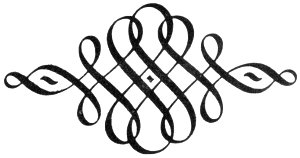
At the battle of Chickamauga, the 22nd Michigan Infantry lost 58.
At Lookout Mountain, the 149th N. Y. Infantry lost 10.
At Missionary Ridge, the 15th Indiana Infantry lost 24.
At the battle of Gettysburg (Pa.), the 24th Michigan Infantry (Union) lost 69 men, while the 26th North Carolina (Confederate) lost 86.
At Vicksburg (Mississippi), the 4th West Virginia, and the 22nd Iowa (both Union), lost 27 men each.
During the Civil War, there were 10 regiments which in various battles lost 75 men or more. They are as follows:
| Regiment and Battle | Number Killed |
| 6th Alabama Infantry at Fair Oaks, Va. | 91 |
| 1st Maine Heavy Artillery at Petersburg, Va. | 90 |
| 26th North Carolina Infantry at Gettysburg, Pa. | 86 |
| 1st South Carolina Rifles at Gains Mill, Va. | 86 |
| 1st Maine Heavy Artillery at Spotsylvania, Va. | 81 |
| 8th New York Infantry at Cold Harbor, Va. | 80 |
| 5th New York Infantry at Manassas, Va. | 79 |
| 70th New York Infantry at Williamsburg, Va. | 79 |
| 1st Missouri Infantry (Union) at Wilson’s Creek, Va. | 76 |
| 23rd U. S. Colored at Petersburg Mine, Va. | 75 |
New York led all other states in the number of troops which they furnished the Union army. The 10 leaders are as follows:
| New York | 448,850 |
| Pennsylvania | 337,936 |
| Ohio | 313,180 |
| Illinois | 259,092 |
| Indiana | 196,363 |
| Massachusetts | 146,730 |
| Missouri[1] | 109,111 |
| Wisconsin | 91,327 |
| Michigan | 87,364 |
| New Jersey | 76,814 |
| Iowa | 76,242 |
| Kentucky[1] | 75,670 |
The leading Union and Confederate officers who were in the battles of Chickamauga, or Chattanooga, or both, are as follows:
Gen. Ulysses S. Grant
Maj. Gen. William S. Rosecrans
Maj. Gen. William T. Sherman
Maj. Gen. George H. Thomas
Maj. Gen. Joseph Hooker
Maj. Gen. Gordon Granger
Maj. Gen. Thomas L. Crittenden
Maj. Gen. Alexander McD. McCook
Gen. Braxton Bragg
Lt. Gen. James Longstreet
Maj.-Gen. Simon B. Buckner
Lt. Gen. Leonidas Polk
Brig. Gen. John B. Hood
Brig. Gen. Nathan B. Forrest
Maj. Gen. Joseph Wheeler
Lt. Gen. Daniel H. Hill
In order that you may know where these high-ranking officers were from, the following offers an accurate account:
1. Gen. Grant was born in Point Pleasant, Ohio, April 27, 1822.
Died in Mt. McGregor (near Saratoga), N. Y., July 23, 1885.
2. Gen. Rosecrans was born in Kingston, Ohio, Sept. 6, 1818.
Died in Redondo, California, March 11, 1898.
3. Gen. Sherman was born in Lancaster, Ohio, Feb. 8, 1820.
Died in New York, Feb. 14, 1891.
4. Gen. Thomas was born in Southhampton Co., Va., July 31, 1816.
Died in San Francisco, California, March 28, 1870.
5. Gen. Hooker was born in Hadley, Mass., Nov. 13, 1814.
Died in Philadelphia, Pa., Nov. 6, 1872.
6. Gen. Granger was born in New York, N. Y., in 1821.
Died in Santa Fe., New Mexico, Jan. 10, 1876.
7. Gen. Crittenden was born in Russellville, Ky., May 15, 1815.
Died in Staten Island, N. Y., Oct. 23, 1893.
8. Gen. McCook was born in Columbiana Co., Ohio, April 22, 1831.
Died in Dayton, Ohio, June 12, 1903.
1. Gen. Bragg was born in Warren Co., N. C., March 22, 1817.
Died in Galveston, Texas, Sept. 27, 1876.
2. Gen. Longstreet was born in Edgefield District, S. C., Jan. 8, 1821.
Died in Gainesville, Georgia, Jan. 2, 1904.
3. Gen. Hood was born in Owingsville, Ky., June 1, 1831.
Died in New Orleans, La., Aug. 30, 1879.
4. Gen. Buckner was born in Munfordville, Ky., April 1, 1823.
Died at same place Jan. 8, 1914.
5. Gen. Polk was born in Raleigh, N. C., April 10, 1806.
Killed by a cannon-ball on Pine Mt., near Marietta, Ga., June 14, 1864.
6. Gen. Forrest was born near Chapel Hill, Tenn., July 13, 1821.
Died in Memphis, Tenn., Oct. 29, 1877.
7. Gen. Wheeler was born in Augusta, Ga., Sept. 10, 1836.
Died in Brooklyn, N. Y., Jan. 25, 1906.
8. Gen. Daniel H. Hill was born in Hill’s Iron Work, York District, S. C., July 12, 1821.
Died in Charlotte, N. C., Sept. 25, 1889.
While there were numerous Civil War Prisons, both in the North and South, it is believed that the following were the most prominent:
| NORTHERN PRISONS | |
|---|---|
| Name | Location |
| Camp Chase | Columbus, Ohio |
| Camp Morton | Indianapolis, Indiana |
| Elmira Prison Barracks | Elmira, New York |
| Fort Delaware | In Delaware River |
| Fort Lafayette | New York, N. Y. |
| Fort McHenry | Baltimore, Maryland |
| SOUTHERN PRISONS | |
| Name | Location |
| Andersonville Prison | Andersonville, Georgia |
| Libby Prison | Richmond, Virginia |
| Belle Isle | In James River—Near Richmond, Va. |
| Camp Lawton | Millen, Georgia |
| Castle Pickney | Charleston, South Carolina |
| Camp Ford | Tyler, Texas |
The first shot in the Civil War was fired upon the steamer “Star of the West” off Charleston Harbor, S. C., on Jan. 9, 1861. However, this was more than three months before the war officially started.
The Civil War started with the bombardment of Fort Sumter, S. C., at 4:30 A. M., April 12, 1861.
The first Southern blood was shed on the streets of Baltimore, Md., on April 19, 1861.
The First Confederate Congress was formed in Montgomery, Ala., on Feb. 4, 1861.
Jefferson Davis, of Mississippi, was elected President of the Confederacy on Feb. 9, 1861. Alexander H. Stephens of Georgia was elected Vice-President. The inauguration was on Feb. 18, 1861.
President Lincoln freed the slaves on Sept. 22, 1862.
The Gatling gun was patented Nov. 4, 1862.
The First Colored Regiment was formed Jan. 25, 1863.
South Carolina was the first state to secede; North Carolina was the last. South Carolina seceded from the Union on Dec. 20, 1860. The other states followed in this order: Florida on Jan. 7, 1861; Mississippi on Jan. 9, 1861; Alabama on Jan. 11, 1861; Georgia on Jan. 19, 1861; Louisiana on Jan. 26, 1861; Texas on Feb. 1, 1861; Virginia on April 17, 1861; Tennessee on May 6, 1861; Arkansas on May 18, 1861, and North Carolina on May 21, 1861.
There were more battles fought in Virginia than in any other state. It is reported that more than 400 battles and actions were fought there. The second largest number was fought in Tennessee.
The most eventful “holiday” in the Civil War was July 4, 1863. On this particular date the Tullahoma Campaign ended; the Union army was victorious at Gettysburg and Vicksburg fell.
Pickett’s famous charge at Gettysburg was the most colorful event of the Civil War.
Ohio furnished almost one-third of the Union troops at the battles of Chickamauga and Chattanooga.
General Robert E. Lee was once offered the command of all the Union forces in the United States, but he declined the offer.
Gen. Albert Sidney Johnston, one of the South’s ablest commanders, resigned the Colonelcy of the 2nd U. S. Cavalry to enter the service of the Confederacy. Gen. Johnston was killed at the Battle of Shiloh.
There were approximately 87,000 men who hired their fighting done. This number, whom were drafted, paid commutation and were exempted from service.
There were almost an even 100,000 of the U. S. Colored Troops whom were recruited from the Confederate States.
About 250 of the Regular U. S. Volunteers were ex-Confederate soldiers.
All of the Confederate States had troops in the Union Army. The data below will furnish proof of this statement:
Alabama—1 Regiment Heavy Artillery; 2 Regiments of Cavalry; 1 Co. of Cavalry; 2 Regiments of Infantry.
Arkansas—2 Batteries of Light Artillery; 4 Regiments of Cavalry; 1 Co. of Cavalry; 1 Infantry Battalion; 1 Co. of Infantry; 9 Regiments of Infantry.
Florida—1 Battery of Light Artillery; 3 Regiments of Cavalry; 1 Co. of Infantry.
Georgia—1 Infantry Battalion.
Louisiana—1 Regiment of Heavy Artillery; 1 Battery of Light Artillery; 4 Regiments of Light Artillery; 1 Co. of Cavalry; 3 Regiments of Cavalry; 18 Regiments of Infantry.
Mississippi—2 Regiments of Heavy Artillery; 2 Regiments of Cavalry; 2 Cos. of Cavalry; 9 Regiments of Infantry.
North Carolina—1 Regiment of Heavy Artillery; 7 Regiments of Infantry.
South Carolina—5 Regiments of Infantry (all Colored).
Texas—1 Battalion of Cavalry; 2 Regiments of Cavalry; 3 Cos. of Infantry.
Virginia—1 Battalion of Cavalry; 1 Regiment of Infantry; 1 Co. of Infantry.
There were four states which were considered “divided” states, namely: Tennessee, Kentucky, Missouri and Maryland. Tennessee furnished more Confederate troops than Union troops. The others furnished more Union troops than Confederates.
The highest regimental number of the Civil War was furnished by the State of Pennsylvania, being the 215th. Ohio was second with 197: New York third with 193, while Illinois and Indiana tied for fourth place with 156 each.
West Point Academy was founded on March 16, 1802.
The U. S. Naval Academy opened October 10, 1845.
The Mexican War started on March 28, 1846.
The most daring and useless episode of the Civil War was performed by Andrews and his raiders when they stole the engine “General.” This feat, if it had been carried out in detail, would only have been temporary. The tearing up of railroad bridges and the destruction of communication lines was almost daily routine at one place or another. This historic engine is now on display at the Union railroad station, Ninth and Broad Streets, Chattanooga, Tennessee.
The Chattanooga National Cemetery is the oldest National Cemetery in the United States. There are soldiers buried in this cemetery as a result of every war the United States has ever participated in, beginning with the Revolutionary War.
There are no Confederate soldiers buried in any National Cemetery. They are buried in Confederate cemeteries or elsewhere. Two such cemeteries are located in, and near Chattanooga. One is located on E. Third Street, adjoining the Jewish Cemetery. The other is located on U. S. Highways No. 11 and 64 at Silverdale, about 10 miles northeast of Chattanooga.
Practically all of the Union and Confederate soldiers who were killed at Chickamauga were buried on that battlefield for a period of about three months. The troops were buried in separate trenches. Then they were removed. The Union soldiers were re-buried in the National Cemetery in Chattanooga. The Confederates were taken to Marietta, Georgia, where they were reburied in the Confederate Cemetery.
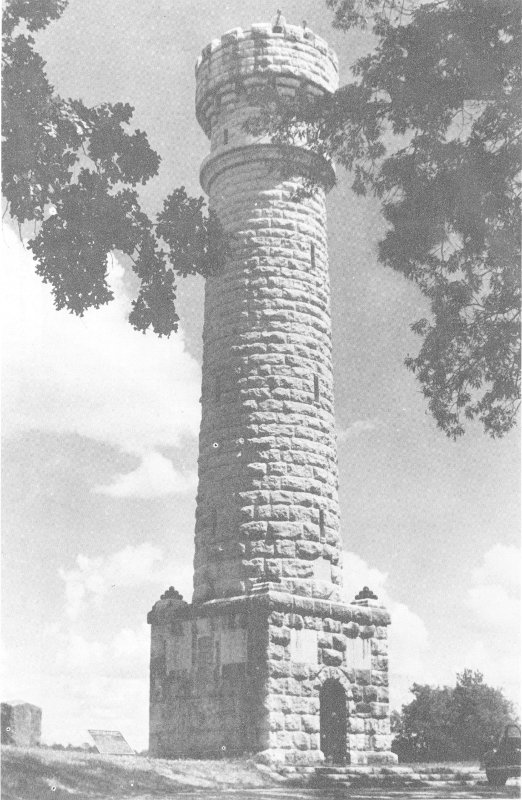
General Wilder’s Monument, Chickamauga Battlefield
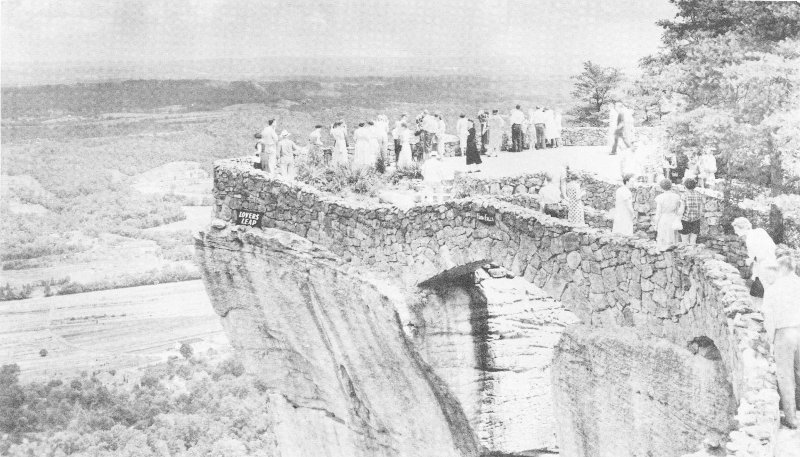
View of Lover’s Leap, Rock City Gardens, atop Lookout Mountain
The last battle of the Civil War was fought near Palo Alto, Texas, on May 13, 1865, more than a month after Lee’s surrender at Appomattox. Col. Barrett commanded the Union troops; Gen. Slaughter the Confederate. This battle resulted in a Confederate victory.
There are numerous headquarters sites in Chattanooga today which were very prominent during the Civil War. In order that you may know the exact location of these sites, they are as follows:
The headquarters of Gen. U. S. Grant and his successor, Gen. William T. Sherman, is a frame house located at 110 East First Street, between Walnut and Cherry streets.
The northeast corner of Fourth and Walnut streets marks the headquarters of Gen. James A. Garfield, Chief of Staff to Gen. Rosecrans, and Gen. Joseph J. Reynolds, Chief of Staff to Gen. Thomas.
Upon first occupation of Chattanooga by Union troops, Brig. Gen. George D. Wagner established headquarters at 407 East Fifth Street. There is a short post erected at this address to mark the site.
Fort Sheridan was located at 1219 East Terrace. A shell pyramid has been erected at this site.
The Standpipe of the City Water Company of Chattanooga marks the center of Fort Wood.
A short post at 502 East Fifth Street marks the location of Lunette O’Meara.
Fort Milhalotzy was located on Cameron Hill. A stone gate post at 221 Boynton Terrace marks the exact location.
Brig. Gen. Thomas J. Wood, U. S. V., commanding the 3rd and 4th Army Corps, had his headquarters at 504 Vine Street, where a short post is today.
The site of Fort Phelps (Negley) which was begun by the Confederates as Fort Cheatham is located at 1706 Read Avenue.
Maj. Gen. Joseph Wheeler, C. S. A., commanding Cavalry Corps, had his headquarters at 515 Douglas Street.
At 309 West Sixth Street you will see a long post which marks the headquarters of Lt. Gen. Daniel C. Hill, C. S. A., command corps, and later this same site was used by Maj. Gen. John M. Palmer, U. S. V., commanding 14th Army Corps, Army of the Cumberland.
Maj. Gen. John C. Breckinridge, C. S. A., commanding a division, had his headquarters at 415 Poplar Street.
Battery Smartt, Confederate work of Cheatham’s division, was located at 10 Bluff View, where a concrete post has been erected.
Gen. Bragg’s headquarters in 1862 were at 407 East Fifth Street.
The southeast corner of Fifth and Walnut streets is the Signal Hill site of Redoubt Putnam, south salient of Fort Sherman.
The Crutchfield House was located where the Ninth Street entrance to the Read House is today.
The 10th Ohio Volunteer Infantry was camped at 654 Houston Street. Incidentally, this is where the first shell fired from Lookout Mountain exploded.
The Custom House lawn on East Eleventh Street marks the location of Redoubt Jones’ (Hazen) headquarters.
Battery Bushnell was located at the northeast corner of Battery Place and Linsay streets.
Brig. Gen. John M. Brannan, Chief of Artillery, Army of the Cumberland, had his headquarters at 302 Walnut Street.
Brig. Gen. Absalom Baird, U. S. V., commanding 14th Army Corps, was located on the south side of West Ninth Street, between East Terrace and Cedar Streets. A long post at this address marks the site.
The College building which accommodated 100 wounded soldiers was located on the northeast corner West Eleventh and Cedar streets.
The Army of the Cumberland (Union) commanded by Maj. Gen. William S. Rosecrans, consisted of the following:
| 14th Army Corps | Maj. Gen. George H. Thomas |
| 20th Army Corps | Maj. Gen. Alexander McD. McCook |
| 21st Army Corps | Maj. Gen. Thomas L. Crittenden |
| Cavalry Corps | Brig. Gen. Robert B. Mitchell |
| Reserve Corps | Maj. Gen. Gordon Granger |
Thomas had 4 divisions, commanded by Baird, Negley, Brannan and Reynolds.
Baird had 3 brigades, commanded by Scribner, Starkweather and John H. King.
Negley had 3 brigades, commanded by John Beatty, Stanley and Sirwell.
Brannan had 3 brigades, commanded by Connell, Croxton and Van Derveer.
Reynolds had 3 brigades, commanded by Wilder, Edward A. King and Turchin.
McCook had 3 divisions, commanded by Jefferson C. Davis, Richard W. Johnson and Sheridan.
Davis had 3 brigades, commanded by Post, Carlin and Heg.
Johnson had 3 brigades, commanded by Willich, Dodge and Baldwin.
Sheridan had 3 brigades, commanded by Lytle, Laiboldt and Bradley.
Crittenden had 3 divisions, commanded by Thomas J. Wood, Palmer and Van Cleve.
Wood had 3 brigades, commanded by Geo. P. Buell, Wagner and Harker.
Palmer had 3 brigades, commanded by Cruft, Hazen and Gross.
Van Cleve had 3 brigades, commanded by Sam Beatty, Dick and Barnes.
Granger had 1 division, commanded by Steedman, consisting of 2 brigades, commanded by Whitaker and Mitchell. The 2nd brigade of Morgan’s division commanded by Daniel McCook, also participated in the battle.
Mitchell had 2 divisions, commanded by Edward M. McCook and Crook.
McCook had 3 brigades, commanded by Campbell, Ray and Watkins.
Crook had 2 brigades, commanded by Minty and Long.
Of these 38 brigades, 36 were engaged. Post’s brigade was guarding supply trains. Wagner’s brigade was stationed at Chattanooga during the battle. Wilder’s brigade was detached and serving as mounted infantry. There were two regiments not engaged. The 9th Michigan Infantry and the 38th Ohio Infantry were guarding trains and performing Provost Duty. The 39th Indiana Infantry also served as mounted infantry (being detached).
The Army of Tennessee, commanded by Gen. Braxton Bragg, consisted of the following:
Buckner’s Corps
Hill’s Corps
Longstreet’s (Hood’s) Corps
Polk’s Corps
Walker’s (Reserve) Corps
Forrest’s (Cavalry) Corps
Wheeler’s (Cavalry) Corps
Buckner had 2 divisions, commanded by Stewart and Preston.
Stewart had 3 brigades, commanded by Bates, Clayton and Brown.
Preston had 3 brigades, commanded by Gracie, Trigg and Kelly.
Hill had 2 divisions, commanded by Cleburne and Breckinridge.
Cleburne had 3 brigades, commanded by Wood, Polk and Deshler.
Breckinridge had 3 brigades, commanded by Helm, Adams and Stovall.
Longstreet had 3 divisions, commanded by McLaws, Hood and Johnson.
McLaw’s had 4 brigades, commanded by Kershaw, Wofford, Humphreys and Bryan.
Hood had 5 brigades, commanded by Jenkins, Law, Robertson, Anderson-Benning.
Johnson had 3 brigades, commanded by Gregg, McNair and Johnson.
Polk had 2 divisions, commanded by Cheatham and Hindman.
Cheatham had 5 brigades, commanded by Jackson, Maney, Smith, Wright and Strahl.
Hindman had 3 brigades, commanded by Anderson, Deas and Manigault.
Walker had 2 divisions, commanded by Gist and Liddell.
Gist had 3 brigades, commanded by Colquitt, Ector and Wilson.
Liddell had 2 brigades, commanded by Govan and Walthall.
Forrest had 2 divisions, commanded by Armstrong and Pegram.
Armstrong had 2 brigades, commanded by James T. Wheeler and Dibrell.
Pegram had 2 brigades, commanded by Davidson and Scott.
Wheeler had 2 divisions, commanded by Wharton and Martin.
Wharton had 2 brigades, commanded by Crews and Harrison.
Martin had 2 brigades, commanded by Morgan and Russell.
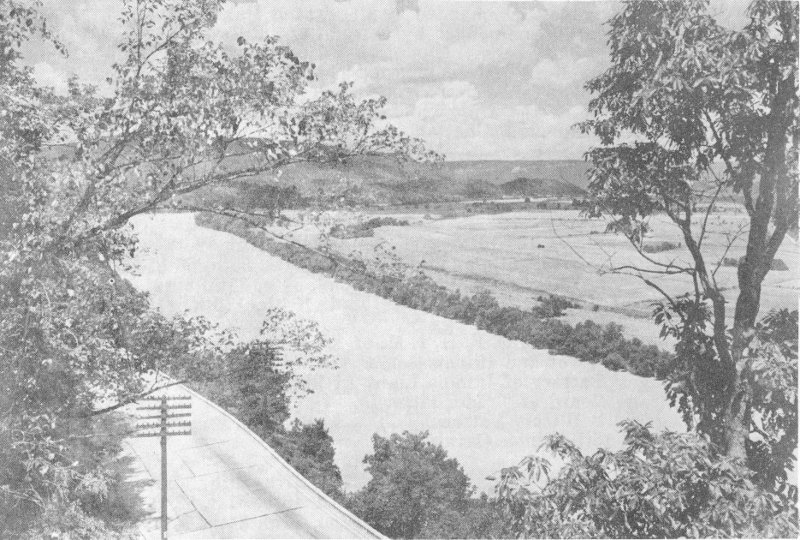
Point Park on Lookout Mountain is easily reached by well paved highways.
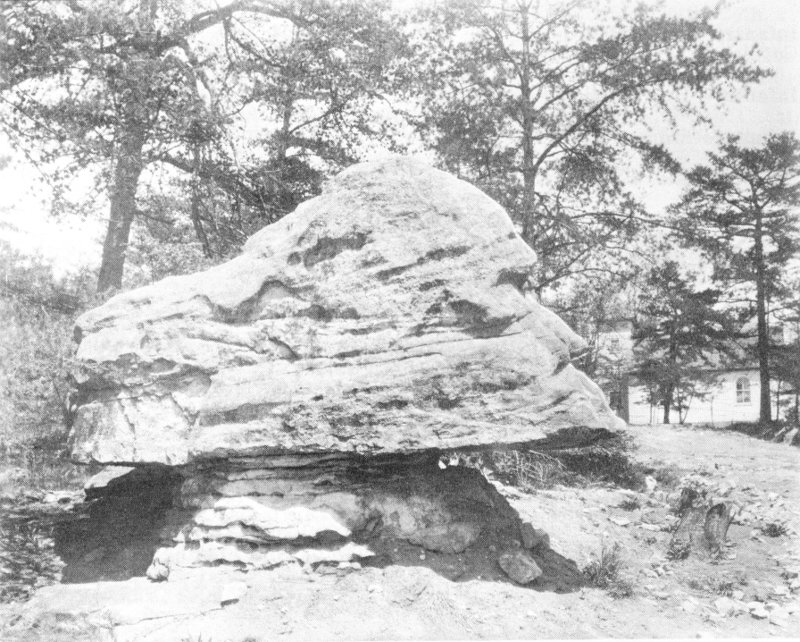
The Old Man of the Mountain—Natural Rock, Lookout Mountain
Of a total of 47 brigades (including 2 artillery brigades), 43 of them were engaged. Bryan, Wofford and Jenkins did not arrive in time for battle. Longstreet’s Artillery Corps failed to arrive in time for the battle.
Complete index of the Union and Confederate troops who participated in the battles of Chickamauga, Chattanooga, or both.
Infantry—5th and 20th.
Infantry—10th, 13th, 16th, 19th, 21st, 22nd, 24th, 25th, 26th, 27th, 29th, 34th, 35th, 36th, 38th, 40th, 42nd, 44th, 48th, 51st, 55th, 56th, 59th, 60th, 63rd, 73rd, 74th, 75th, 78th, 79th, 80th, 82nd, 84th, 85th, 86th, 88th, 89th, 90th, 92nd, 93rd, 96th, 100th, 101st, 103rd, 104th, 110th, 115th, 116th, 123rd, 125th, 127th.
Artillery—Batteries, A, B, C, F, H, I, M, of 1st Illinois Light Artillery.
Battery “I” of 2nd Illinois Light Artillery.
Bridges’ Battery of Illinois Light Artillery.
Chicago Board of Trade Battery.
Cogswell’s Illinois Battery.
Cavalry—Co. K, 15th Illinois Cavalry.
Infantry—6th, 9th, 10th, 12th, 15th, 17th, 22nd, 27th, 29th, 30th, 31st, 32nd, 35th, 36th, 37th, 38th, 39th, 40th, 42nd, 44th, 48th, 51st, 52nd, 57th, 58th, 59th, 68th, 72nd, 74th, 75th, 79th, 81st, 82nd, 83rd, 84th, 86th, 87th, 88th, 97th, 99th, 100th, 101st.
Artillery—4th, 5th, 7th, 8th, 10th, 11th, 18th, 19th, 21st, Batteries of Indiana Light Artillery.
Cavalry—2nd, 3rd, 4th.
Infantry—4th, 5th, 6th, 9th, 10th, 17th, 25th, 26th, 30th, 31st.
Artillery—1st Battery of Iowa Light Artillery.
Infantry—8th.
Infantry—1st, 2nd, 3rd, 4th, 5th, 6th, 8th, 9th, 10th, 15th, 17th, 18th, 21st, 23rd.
Cavalry—2nd, 4th, 5th, 6th.
Infantry—1st Battalion 10th Infantry.
Infantry—3rd.
Infantry—2nd, 33rd.
Infantry—9th, 10th, 11th, 13th, 14th, 15th, 21st, 22nd.
1st Michigan Engineers.
Cavalry—2nd, 4th.
Artillery—Batteries “A” and “D” of 1st Light Artillery.
Infantry—2nd, 4th.
Artillery—2nd Battery of Minnesota Light Artillery.
Infantry—2nd, 3rd, 6th, 8th, 10th, 12th, 15th, 17th, 24th, 26th, 27th, 29th, 31st, 32nd.
Artillery—Batteries “D” and “G” of 1st Light Artillery. Battery “F” of 2nd Light Artillery.
Infantry—13th, 33rd.
Infantry—8th (Independent Co.), 45th, 58th, 60th, 68th, 78th, 102nd, 107th, 119th, 123rd, 134th, 136th, 137th, 141st, 143rd, 145th, 149th, 150th, 154th.
Artillery—Battery “I” of 1st Light Artillery. 13th Battery of Light Artillery.
Infantry—1st, 2nd, 3rd, 5th, 6th, 7th, 9th, 10th, 11th, 13th, 14th, 15th, 17th, 18th, 19th, 21st, 24th, 26th, 29th, 30th, 31st, 33rd, 35th, 36th, 37th, 38th, 40th, 41st, 46th, 47th, 49th, 51st, 52nd, 53rd, 54th, 55th, 57th, 59th, 61st, 64th, 65th, 66th, 69th, 70th, 73rd, 74th, 76th, 80th, 82nd, 89th, 90th, 92nd, 93rd, 94th, 97th, 98th, 99th, 101st, 105th, 108th, 113th, 121st, 124th, 125th. 1st Battalion Sharpshooters.
Artillery—Batteries A, B, C, D, E, F, G, I, K, M, of 1st Ohio Light Artillery. 4th, 6th, 18th, 20th Batteries of Ohio Light Artillery.
Cavalry—1st, 3rd, 4th, 10th.
Infantry—27th, 28th, 29th, 46th, 73rd, 75th, 77th, 78th, 79th, 109th, 111th.
Artillery—Batteries “B” and “E” of Pennsylvania Light Artillery.
Battery “B” of 26th Pennsylvania Independent Artillery.
Cavalry—7th, 9th, 15th.
Infantry—4th.
Infantry—1st, 3rd, 10th, 15th, 18th, 21st, 24th, 26th.
Artillery—3rd, 5th, 6th, 8th, 10th, 12th, Batteries of Light Artillery.
Company “C” of 1st Heavy Artillery.
Cavalry—1st.
Artillery—Battery “A” of 1st Tennessee Light Artillery.
Cavalry—1st, 2nd.
Infantry—15th, 16th, 18th, 19th.
1st Battalion of 13th.
Artillery—Batteries G, H, I, M of 4th U. S. Artillery.
Batteries H and K of 5th U. S. Artillery.
Cavalry—4th.
Infantry—4th, 14th, 15th, 16th, 17th, 18th, 19th, 20th, 22nd, 23rd, 24th, 25th, 28th, 30th, 31st, 32nd, 33rd, 34th, 36th, 37th, 38th, 39th, 40th, 41st, 42nd, 43rd, 44th, 45th, 46th, 47th, 48th, 50th, 58th. 17th Battalion Sharpshooters; 1st, 2nd, 3rd, 4th Alabama Battalions; 18th Alabama Battalion; Hilliard’s Legion; Stone’s Battalion Sharpshooters.
Cavalry—1st, 3rd, 4th, 5th, 51st, 53rd, Holloway’s Company Alabama Cavalry; Lenoir’s Company Alabama Cavalry; Malone’s Regiment Alabama Cavalry; Moreland’s Battalion Alabama Cavalry.
Artillery—Dent’s Eufaula’s, Fowler’s, Garrity’s, Kolb’s, Lumsden’s, Oliver’s, Semple’s and Water’s Alabama Batteries.
Infantry—1st, 2nd, 3rd, 4th, 5th, 6th, 7th, 8th, 13th, 15th, 19th, 24th, 25th, 31st.
4th Arkansas Battalion; 1st and 2nd Arkansas Mounted Rifles.
Cavalry—3rd.
Artillery—Calvert’s, Humphrey’s, Wiggins’ Arkansas Batteries.
Infantry—1st, 3rd, 4th, 6th, 7th.
Cavalry—1st (Dismounted).
Artillery—McCant’s Florida Battery.
Infantry—1st Georgia (Confederate), 2nd, 5th, 7th, 8th, 9th, 10th, 11th, 15th, 16th, 17th, 18th, 20th, 24th, 25th, 29th, 30th, 34th, 36th, 37th, 39th, 40th, 41st, 42nd, 43rd, 46th, 47th, 50th, 51st, 52nd, 53rd, 56th, 59th, 65th. 1st, 2nd, 3rd, 4th and 8th Battalions Sharpshooters; 26th Georgia Battalion: Cobbs’s and Phillip’s Legion; 1st, 3rd, 5th, 8th and 10th Confederates.
Cavalry—1st, 2nd, 3rd, 4th, 6th.
Artillery—Corput’s, Dawson’s, Ferrell’s, Havis’, Howell’s, Massenburg’s, Peeple’s, Rowan’s, Scogins’, Wolihin’s, York’s Georgia Batteries.
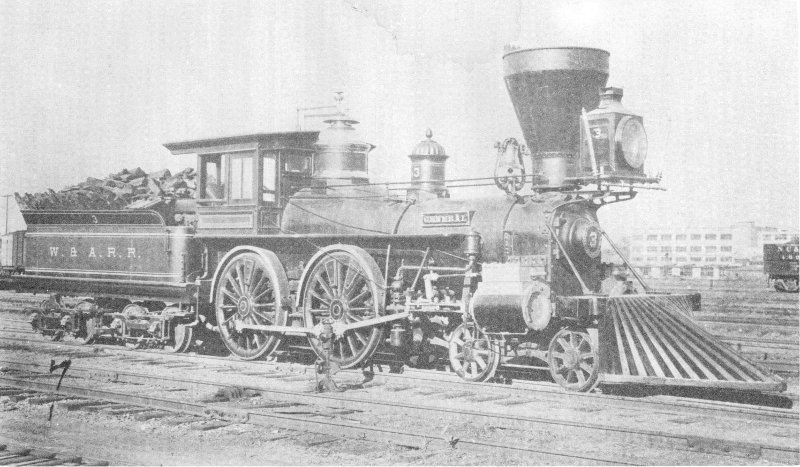
THE “GENERAL”
It was stolen by Andrews’ Raiders. Now in Union Station, Chattanooga, Tennessee
Infantry—2nd, 4th, 5th, 6th, 9th. John H. Morgan’s dismounted men.
Cavalry—1st, 2nd, 3rd, 9th. Clay’s, Jessee’s, Johnson’s Battalions Cavalry.
Artillery—Cobb’s and Graves’ Kentucky Batteries.
Infantry—1st (Regulars), 13th, 16th, 19th, 20th, 25th. 4th and 14th Battalions Sharpshooters.
Cavalry—1st. Dreux’s and Greenleaf’s Company Louisiana Cavalry.
Artillery—LeGardeur’s, Moody’s, Robinson’s (1 section), Slocomb’s Louisiana Batteries.
Infantry—5th, 7th, 8th, 9th, 10th, 13th, 17th, 18th, 21st, 24th, 27th, 29th, 30th, 32nd, 34th, 41st, 44th, 45th. Pound’s Battalion Sharpshooters; 9th and 15th Battalions Sharpshooters.
Cavalry—Foule’s Company Mississippi Cavalry.
Artillery—Darden’s, Smith’s, Standford’s, Sweet’s, Mississippi Batteries.
Warren’s Battery of Mississippi Light Artillery.
Infantry—None.
Cavalry—None.
Artillery—Barret’s and Bledsoe’s Missouri Batteries.
Infantry—29th, 39th, 58th, 60th.
Cavalry—6th.
Artillery—None.
Infantry—1st, 2nd, 3rd, 5th, 6th, 7th, 8th, 9th, 10th, 15th, 16th, 19th, 24th.
3rd Battalion; 2nd South Carolina Rifles; Hampton’s Legion; Palmetto
Sharpshooters.
Cavalry—None.
Artillery—Culpepper’s, Ferguson’s, Fickling’s, James’ South Carolina Batteries.
Infantry—1st, 2nd, 3rd, 4th, 5th, 6th, 8th, 9th, 10th, 11th, 12th, 13th, 15th, 16th, 17th, 18th, 19th, 20th, 23rd, 24th, 25th, 26th, 27th, 28th, 29th, 30th, 31st, 32nd, 33rd, 35th, 37th, 38th, 39th, 41st, 43rd, 44th, 45th, 47th, 48th, 50th, 51st, 52nd, 59th, 63rd, 154th. 1st and 23rd Tennessee Battalions; Murray’s Tennessee Battalions; 3rd and 4th Provisional Army; 24th Battalion Sharpshooters; Dawson’s Battalion Sharpshooters; 3rd, 4th, 5th, 6th, 9th Confederates.
Cavalry—1st, 2nd, 4th, 5th, 6th, 8th, 9th, 10th, 11th. Clark’s, Jackson’s, Sanders’ Company Tennessee Cavalry; Hamilton’s and Shaw’s Tennessee Battalions; Allison’s Tennessee Squadron; 12th, 16th and 18th Battalions; Rucker’s Legion.
Artillery—Baxter’s, Carnes’, Huggins’, Huwald’s, Marshall’s, Mebane’s, Morton’s, Scott’s and White’s Tennessee Batteries.
Infantry—1st, 4th, 5th, 6th, 7th, 9th, 10th.
Cavalry—8th, 10th, 11th, 14th, 15th, 17th, 18th, 24th, 25th, 32nd. (10th, 14th, 15th, 17th, 32nd dismounted—serving as infantry).
Artillery—Douglas’ Texas Battery.
Infantry—54th, 63rd.
Cavalry—Edmundson’s Battalion Cavalry.
Artillery—Jeffress’, Jordan’s, Parker’s, Taylor’s and Woolfolk’s Virginia Batteries.
NOTE: Copies of this Booklet will be mailed direct, postpaid, upon receipt of 50 cents to—
J. L. ROGERS
3203 Dayton Blvd.
CHATTANOOGA, TENNESSEE
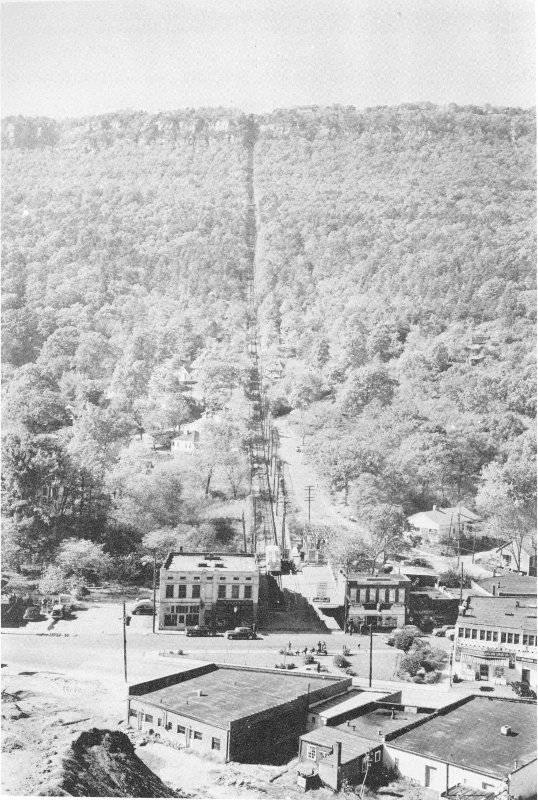
Lookout Mountain Incline. The world’s largest, safest, steepest passenger Incline. A direct route to beautiful Point Park, the outstanding feature on Lookout Mountain.
| CITY | Miles | ROUTES |
|---|---|---|
| Akron, Ohio | 567 | 27-68-62-3-5 |
| Asheville, N. C. | 206 | 64-19 |
| Atlanta, Ga. | 119 | 41 |
| Atlantic City, N. J. | 798 | 11-211-1-40 |
| Augusta, Ga. | 273 | 41-53-129-78 |
| B | ||
| Baltimore, Md. | 660 | 11-11W-11-117-11-211-1 |
| Baton Rouge, La. | 559 | 11-11A-11-26-7-190 |
| Birmingham, Ala. | 150 | 11-11A-11 |
| Bluefield, W. Va. | 320 | 11-11W-23-71-19 |
| Boston, Mass. | 1060 | N.Y.—Pkwys. 15-20-9 |
| Bowling Green, Ky. | 189 | 41-231 |
| Brunswick, Ga. | 404 | 41-341 or 41-23-341 |
| Buffalo, N. Y. | 777 | 27-68-62-3-42-20-5 |
| C | ||
| Cedar Rapids, Ia. | 762 | Via St. Louis 61-218 |
| Charleston, W. Va. | 438 | 11-33-25E-119 |
| Charleston, S. C. | 416 | 41-53-129-78 |
| Charlotte, N. C. | 317 | 64-19-74 |
| Chicago, Ill. | 593 | 41-41A-41 |
| Cincinnati, O. | 350 | 27-25 (359 Mi. Via 27) |
| Cleveland, Ohio | 585 | 27-68-3-42 |
| Clearwater, Fla. | 616 | 41-19 |
| Columbia, S. C. | 328 | 41-53-129-78-378 |
| Columbus, Ga. | 210 | 27 |
| Columbus, Ohio | 444 | 27-68-62 |
| D | ||
| Dallas, Tex. | 801 | 64-70-67 |
| Davenport, Ia. | 660 | 41-41A-41-50-1-150 |
| Dayton, Ohio | 402 | 27-25 |
| Daytona Beach, Fla. | 538 | 41-341-41-100-1 or Atlanta 23-1 |
| Denver, Col. | 1326 | St. Louis—40-24-40 |
| Des Moines, Ia. | 805 | St. Louis—40-63-163 |
| Detroit, Mich. | 608 | 27-25 or 27-227-68-24-25 |
| E | ||
| El Paso, Tex. | 1431 | 64-70-67-80 |
| Evansville, Ind. | 308 | 41-41A-41 |
| F | ||
| Ft. Myers, Fla. | 709 | 41-341-41 |
| Ft. Wayne, Ind. | 503 | 27-25-127-177-227-27 |
| Frankfort, Ky. | 276 | 27-150-35 |
| G | ||
| Gatlinburg, Tenn. | 146 | 64-411-73 |
| Grand Rapids, Mich. | 652 | Ft. Wayne—33-13-131 |
| Greensboro, N. C. | 389 | 64-19-70 |
| H | ||
| Hartford, Conn. | 959 | N.Y.—Pkwys. 15-5 |
| Houston, Texas | 839 | 11-11A-11-26-7-190-185-90 |
| I | ||
| Indianapolis, Ind. | 415 | 41-231-31E-351-31W-31 |
| J | ||
| Jackson, Miss. | 404 | 11-11A-11-80 |
| Jacksonville, Fla. | 444 | 41-341-23 or Atlanta 23 |
| K | ||
| Kansas City, Mo. | 710 | 41-41A-41-68-45-146-3-40 |
| Key West, Fla. | 953 | 41-341-41-100-1 |
| Knoxville, Tenn. | 114 | 11 |
| L | ||
| Lake City, Fla. | 421 | 41-341-41 |
| Lansing, Mich. | 627 | 27-25-127 |
| Lexington, Ky. | 267 | 27 |
| Little Rock, Ark. | 458 | 64-70 |
| Los Angeles, Calif. | 2169 | 64-266-62-66-89A-89 71-60 |
| Louisville, Ky. | 302 | 41-231-31E-351-31W |
| M | ||
| Macon, Ga. | 212 | 41 or Atlanta 23 |
| Mammoth Cave, Ky. | 223 | 41-231-31E-351-31W-70 |
| Memphis, Tenn. | 325 | 64 |
| Meridian, Miss. | 309 | 11-11A-11 |
| Miami, Fla. | 796 | Daytona—1 (869 Mi. Via 27) |
| Milwaukee, Wis. | 675 | 41-41A-41 |
| Minneapolis, Minn. | 987 | 41-41A-52-45-12 |
| Mobile, Ala. | 403 | 11-11A-11-5-43 |
| Montgomery, Ala. | 239 | 11-241-231 (250 Mi. -11 11A-31) |
| N | ||
| Nashville, Tenn. | 138 | 41 |
| New Haven, Conn. | 922 | New York—1 |
| New Orleans, La. | 515 | 11-11A-11 |
| New York City, N. Y. | 854 | 11-11W-11-117-11-211 I-40—N.J. Tnpk. 1 |
| Norfolk, Va. | 619 | 11-11W-11-52-58—Ferry or Tunnel |
| O | ||
| Oklahoma City, Okla. | 806 | 64-266-62 |
| Omaha, Nebr. | 918 | St. Louis—61-36-71-275 |
| Orlando, Fla. | 585 | 41-341-41-27-441 |
| P | ||
| Paducah, Ky. | 291 | 41-68 |
| Palm Beach, Fla. | 730 | 41-341-41-100-1 |
| Peoria, Ill. | 560 | 41-41A-41-50-1-150 |
| Philadelphia, Pa. | 759 | 11-11W-11-117-11-211 1-40-13 |
| Pittsburgh, Pa. | 618 | 11-11W-23-71-19 |
| Providence, R. I. | 1024 | N.Y. Pkwys. 15-6A-6 |
| R | ||
| Raleigh, N. C. | 456 | 64-19-70-64 |
| Richmond, Va. | 557 | 11-11W-11-460-24-60 |
| Roanoke, Va. | 339 | 11-11W-11 |
| Rock City | 6 | 41-58 |
| S | ||
| St. Augustine, Fla. | 482 | 41-341-23-1 |
| St. Louis, Mo. | 462 | 41-41A-68-45-146-3-40 |
| St. Petersburg, Fla. | 610 | 41-341-41-92 or 41-19 |
| Salt Lake City, Utah | 839 | St. Louis—40-24-40 |
| San Antonio, Tex. | 1019 | 11-11A-11-26-7-190 165-90 |
| San Francisco, Calif. | 2491 | 64-266-62-66-466-99-50 |
| Sarasota, Fla. | 643 | 41-341-41 |
| Savannah, Ga. | 389 | Macon—80 |
| Shreveport, La. | 630 | 11-80 |
| Silver Springs, Fla. | 512 | 41-341-41-27-40 |
| Spokane, Wash. | 2439 | 41-14-16-87-10 |
| T | ||
| Tallahassee, Fla. | 378 | 27 |
| Tampa, Fla. | 590 | 41-341-41 |
| Terre Haute, Ind. | 408 | 41-41A-41 |
| Texarkana, Ark. | 613 | 64-70-67 |
| Toledo, Ohio | 551 | 27-25 or 27-227-68 |
| Toronto, Ontario | 839 | Detroit—Canada 2-5 |
| V | ||
| Valdosta, Ga. | 357 | 41-341-41 |
| W | ||
| Washington, D. C. | 622 | 11-11W-11-117-11-211 |
| Wheeling, W. Va. | 563 | 11-33-25E-119-21-2 |
| Wilmington. Del. | 731 | 11-11W-11-117-11-211 1-40-13 |
| Wilmington, N. C. | 519 | 41-53-129-78-378-76 |
| Winston Salem, N. C. | 360 | 64-19-70-64-158 |